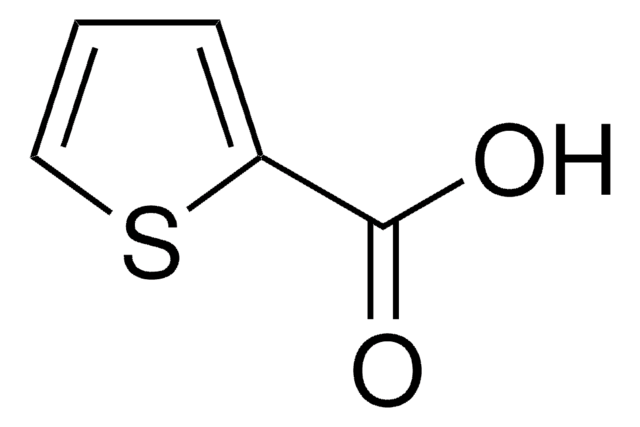W392103
2,4-Hexadienoic acid
≥99%, FCC
Sinonimo/i:
Sorbic acid, α-trans-γ-trans-Sorbic acid, (E,E)-1,3-Pentadiene-1-carboxylic acid, 2,4-Hexadienoic acid, 2E,4E-Hexadienoic acid, trans,trans-2,4-Hexadienoic acid, C6:2n-2,4, NSC 35405, NSC 49103, NSC 50268
About This Item
Prodotti consigliati
Origine biologica
synthetic
agenzia
meets purity specifications of JECFA
Conformità normativa
FCC
FDA 21 CFR 166.110
FDA 21 CFR 172.872
FDA 21 CFR 177.2260
FDA 21 CFR 181.23
FDA 21 CFR 182.3089
Tensione di vapore
0.01 mmHg ( 20 °C)
Saggio
≥99%
Forma fisica
powder
Punto di fusione
132-135 °C (lit.)
Solubilità
ethanol: 10%, clear, colorless to slightly yellow
Densità
1.2 g/cm3 at 20 °C
Cationi in tracce
As: ≤3.0 ppm
Cd: ≤1.0 ppm
Hg: ≤1.0 ppm
Pb: ≤2.0 ppm
applicazioni
flavors and fragrances
Documentazione
see Safety & Documentation for available documents
Allergene alimentare
no known allergens
Organolettico
odorless
Stringa SMILE
C\C=C\C=C\C(O)=O
InChI
1S/C6H8O2/c1-2-3-4-5-6(7)8/h2-5H,1H3,(H,7,8)/b3-2+,5-4+
WSWCOQWTEOXDQX-MQQKCMAXSA-N
Cerchi prodotti simili? Visita Guida al confronto tra prodotti
Avvertenze
Warning
Indicazioni di pericolo
Consigli di prudenza
Classi di pericolo
Eye Irrit. 2 - Skin Irrit. 2
Codice della classe di stoccaggio
11 - Combustible Solids
Classe di pericolosità dell'acqua (WGK)
WGK 1
Punto d’infiammabilità (°F)
260.6 °F - closed cup
Punto d’infiammabilità (°C)
127 °C - closed cup
Dispositivi di protezione individuale
dust mask type N95 (US), Eyeshields, Gloves
Certificati d'analisi (COA)
Cerca il Certificati d'analisi (COA) digitando il numero di lotto/batch corrispondente. I numeri di lotto o di batch sono stampati sull'etichetta dei prodotti dopo la parola ‘Lotto’ o ‘Batch’.
Possiedi già questo prodotto?
I documenti relativi ai prodotti acquistati recentemente sono disponibili nell’Archivio dei documenti.
I clienti hanno visto anche
Il team dei nostri ricercatori vanta grande esperienza in tutte le aree della ricerca quali Life Science, scienza dei materiali, sintesi chimica, cromatografia, discipline analitiche, ecc..
Contatta l'Assistenza Tecnica.










